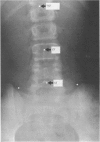Abstract
The vertebra prominens is found most frequently at C7 in both sexes (78.7% of 47 females, 58.8% of 17 males). It is frequently at T1 in females (3 of 47: 6.4%) though not uncommonly so in males (6 of 17: 35%). The first spinous process felt at the lower end of the nuchal furrow is an unreliable guide to the vertebra prominens in the female (being at C6 in 59.6% of female subjects and coinciding with the vertebra prominens in only 46.8%). The sacral dimples have a wide distribution in vertebral level and are unreliable as surface vertebral landmarks. The generally accepted vertebral level of sacral dimples being at S2 is disputed, being present at this level in only 5 of 68 subjects (7.4%). There is a significant sex difference in the location of sacral dimples, being higher relative to vertebrae in females than in males, P less than 0.05. This finding is related particularly to the greater pelvic height of adolescent girls compared with boys.
Full text
PDF







Images in this article
Selected References
These references are in PubMed. This may not be the complete list of references from this article.
- Burwell R. G., James N. J., Johnson F., Webb J. K., Wilson Y. G. Standardised trunk asymmetry scores. A study of back contour in healthy school children. J Bone Joint Surg Br. 1983 Aug;65(4):452–463. doi: 10.1302/0301-620X.65B4.6874719. [DOI] [PubMed] [Google Scholar]
- Drerup B., Hierholzer E. Objective determination of anatomical landmarks on the body surface: measurement of the vertebra prominens from surface curvature. J Biomech. 1985;18(6):467–474. doi: 10.1016/0021-9290(85)90282-9. [DOI] [PubMed] [Google Scholar]
- MacGibbon B., Farfan H. F. A radiologic survey of various configurations of the lumbar spine. Spine (Phila Pa 1976) 1979 May-Jun;4(3):258–266. doi: 10.1097/00007632-197905000-00013. [DOI] [PubMed] [Google Scholar]
- Nicolopoulos K. S., Burwell R. G., Webb J. K. Stature and its components in healthy children, sexual dimorphism and age related changes. J Anat. 1985 Aug;141:105–114. [PMC free article] [PubMed] [Google Scholar]



